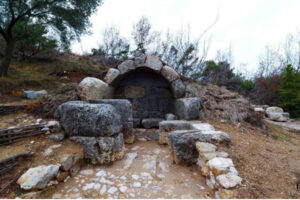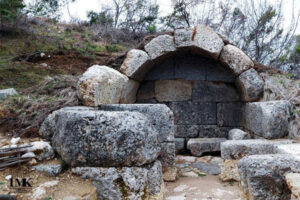The monumental tomb of Persqopi close to Tirana is now restored
The Monumental Tomb is located in the eastern part of the Mountain of the Villa. It is part of the settlement known as the “Ancient Walls and the Perscopian Tomb” on Mount Petrela. Persqop was one of the ancient cities that were not reused for a long time. It is believed that the population moved and settled in Petrela. Today, these old ruins attract tourists to ancient and curious history of archaeological values.

History
The ancient city of Brysak belongs to the Illyrian tribe of Partheni and belonged to the partinian koinon with the capital, Parthen (Berat). This town was next to the Egnatia road beneath it, along the banks of the Erzen River. The city controlled the ancient road from Dyrrah, passed to Tyran and went to Scampin (Durres-Tirana-Elbasan), later part of the Egnatia road. It was the residence of King Illyria Glaukia, who has sheltered the Epirus leader Pirros of Epirus for 10 years from the age of 2 to 12 years, which the Macedonians wanted to kill. They offered King Glaukia a large sum of money but he refused. (Source: ‘Illyrians’ Neritan Ceka)

The city has lived about 1000 years and its splendor has been from 2500 to 200 years ago. With the invasion of Illyria by the Romans, the city fell. In the 4th century AD, construction of the Petrela fortress is now under way and the city loses its function. Fragments of Pelasgic walls are the largest in Albania today preserved since that time. The walls surrounded the hillside and on the eastern side there are the ruins of a monumental tomb (locals call it “The tomb of Christians”). The walls are built with massive stone blocks without bonding material (mortar).
Other News to Read
Heritage is Our Brand- a project or a mission
Albanians’ intangible heritage is wealthy, starting with their language, national symbols, folklore, costumes, legends, ballads, dances, rites, and…
The Holy Month of Ramazan in Albania
On March 1, Muslim believers worldwide, including Albania, Kosovo, and North Macedonia, started the extraordinary spiritual journey: the…
Guardians of the Underground: Why Albania Needs Its Cave Explorers
Deep beneath Albania’s rugged mountains lies a hidden world few have seen: an underground realm of extraordinary caves,…
What to do in March in Tirana
As winter bids farewell and the first hints of spring emerge, Tirana transforms into a canvas of colors…